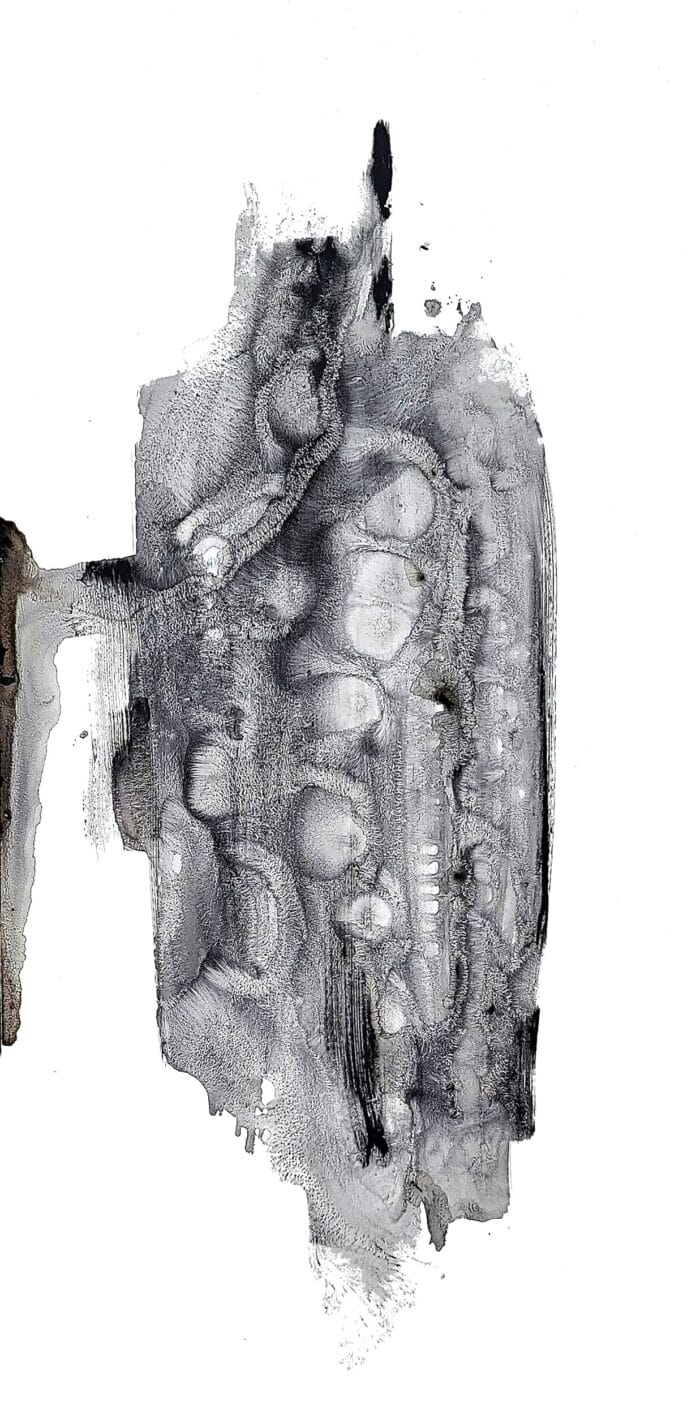Newel Hunter’s painting Balanced is an evocative meditation on form, texture, and contrast. At first glance, the composition appears simple irregular, vertically elongated shape resting in the center of a white background. Yet within this central figure, the eye quickly discovers a world of depth and variation. Layers of black and gray tones overlap in textured surfaces that feel both ancient and immediate, weathered yet alive.
Soft washes blur into subtle gradations, while bold, dark strokes anchor the piece with weight and intensity. The interplay between shadow and light creates a sculptural quality, as if the form has been carved out of stone. Around it, the untouched white space heightens the drama, placing full emphasis on the textured core. The result is an image that compels contemplation, a work at once minimalist in palette but maximalist in feeling.
A Philosophy Beyond Paint
For Hunter, a painting like Balanced is not merely a visual object but a portal into the deeper currents of the human spirit. As he often states:
“It’s not about the paint. Or the canvas. It’s about digging deep enough to stir the soul.”
This philosophy underscores the physical and emotional intensity that defines his process. His paintings are not calculated, pre-planned executions. Instead, they emerge through an almost ritualistic act of creation, where intuition takes precedence over precision. Chance, accident, and spontaneity are not obstacles to be controlled but collaborators to be welcomed.
The Gesture as Story
Hunter’s art is highly gestural, each stroke carrying the weight of motion and the energy of the body that produced it. He describes painting as a “whole body exercise in storytelling,” an act where the floor becomes his ally and the canvas his partner in dialogue. Working flat against the surface, Hunter lets his body’s movement dictate the rhythm of the work.
“I rarely know what I’m going to paint beforehand,” he explains. “The subconscious directs the work and guides my hand. The floor pushes back and keeps me moving.”
In this way, his paintings evolve not as fixed representations but as living narratives, unfolding moment by moment through the interplay of body, mind, and chance.
An Artistic Lineage
Although deeply individual, Hunter’s work is also grounded in an artistic lineage that draws from both European and American traditions of abstraction. He acknowledges the profound influence of the European Art Informel movement, as well as iconic American abstractionists. Names like Franz Kline, Robert Motherwell, Clyfford Still, Hans Hofmann, Gerhard Richter, Willem de Kooning, and Pierre Soulages resonate strongly within his practice.
Much like these predecessors, Hunter gravitates toward black and white as his primary language. Stripped of color, his works focus purely on form, contrast, and texture, the elemental forces of painting. The restraint of palette opens space for intensity, clarity, and emotion to surface without distraction.
Balanced as Reflection
Seen through this context, Balanced becomes more than an isolated image. It embodies Hunter’s philosophy of embracing chance, his reliance on gesture, and his dialogue with the history of abstraction. The central textured form, irregular and raw, resists easy categorization. It could suggest a figure, a monument, or simply the record of an energetic encounter between artist and surface.
The white space, far from being empty, plays a crucial role. It is the silence that allows the textured voice to be heard. Together, the elements create equilibrium, not static but dynamic, like a precarious balance maintained in motion.
International Recognition
Hunter’s commitment to this vision has earned him recognition well beyond his studio. He has exhibited extensively across the United States and Europe, with his works entering the collections of international collectors who value the intensity and authenticity of his approach.
His inclusion as one of only 44 international artists featured in Aleatoric Art in the 21st Century further underscores his unique place in contemporary art. At 240 pages, this coffee table-sized volume has become a definitive exploration of chance and randomness in modern creative practices. Hunter’s presence within it affirms his role as a leading voice in the ongoing dialogue between intention and accident, control and surrender.
The Soul of Abstraction
Ultimately, what makes Hunter’s paintings resonate and what makes Balanced so compelling is their ability to stir something within the viewer that transcends language. His art is not meant to tell us what to see, but to create the conditions where we discover something for ourselves.
Every wash of gray, every stroke of black, every silence of white space invites reflection. They echo the rhythms of life itself: moments of intensity followed by stillness, fractures alongside unity, chaos tempered by calm.
In Hunter’s words, the goal is always to dig deep enough to touch the soul. Balanced achieves exactly that, embodying the paradox at the heart of all great abstraction works that appear stripped down and minimal yet carry infinite emotional weight.


